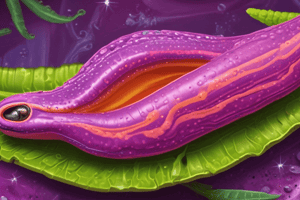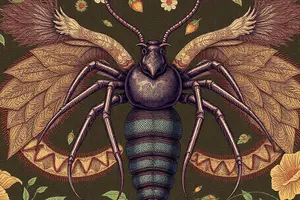Podcast
Questions and Answers
Members of the Class Monogenea are known as _________.
Members of the Class Monogenea are known as _________.
monogeneans
What type of parasites are monogeneans generally?
What type of parasites are monogeneans generally?
ectoparasites
If endoparasitic, where are monogeneans usually found?
If endoparasitic, where are monogeneans usually found?
inside of host's body, bladder or cloaca
What is the typical host for monogeneans?
What is the typical host for monogeneans?
Where on the host are monogeneans found?
Where on the host are monogeneans found?
Which systems are monogeneans lacking?
Which systems are monogeneans lacking?
Which structure is either not present or weakly developed in monogeneans?
Which structure is either not present or weakly developed in monogeneans?
What are monogeneans' attachment structures called?
What are monogeneans' attachment structures called?
The anterior attachment structure of monogeneans is called?
The anterior attachment structure of monogeneans is called?
The posterior attachment structure of monogeneans is called?
The posterior attachment structure of monogeneans is called?
What other structures could the opisthaptor contain?
What other structures could the opisthaptor contain?
Which is the primary attachment structure for monogeneans?
Which is the primary attachment structure for monogeneans?
What type of life cycle do monogeneans have?
What type of life cycle do monogeneans have?
What does a direct life cycle refer to?
What does a direct life cycle refer to?
Can monogeneans cause death to their hosts?
Can monogeneans cause death to their hosts?
Are monogeneans monoecious or dioecious?
Are monogeneans monoecious or dioecious?
What 2 ways can monogeneans reproduce?
What 2 ways can monogeneans reproduce?
Describe the oviparous reproductive method.
Describe the oviparous reproductive method.
What is the larval stage known as that hatches from the oviparous reproduction?
What is the larval stage known as that hatches from the oviparous reproduction?
What is viviparous reproduction?
What is viviparous reproduction?
What is a heavily ciliated larval stage called?
What is a heavily ciliated larval stage called?
Monogeneans use these structures to attach to their hosts:
Monogeneans use these structures to attach to their hosts:
The ciliated larva of a monogenean is called:
The ciliated larva of a monogenean is called:
A direct life cycle refers to having:
A direct life cycle refers to having:
What class do trematodes belong to?
What class do trematodes belong to?
What else are trematodes called?
What else are trematodes called?
What type of parasites are trematodes?
What type of parasites are trematodes?
How do trematodes attach to their host?
How do trematodes attach to their host?
How many suckers do trematodes have?
How many suckers do trematodes have?
What are the two suckers on trematodes called?
What are the two suckers on trematodes called?
What makes trematodes effective parasitic organisms?
What makes trematodes effective parasitic organisms?
Which three things are reduced in trematodes?
Which three things are reduced in trematodes?
What type of life cycle do trematodes have?
What type of life cycle do trematodes have?
Having more than one host refers to which type of life cycle?
Having more than one host refers to which type of life cycle?
What are intermediate hosts?
What are intermediate hosts?
What are definitive hosts?
What are definitive hosts?
What are larva?
What are larva?
What are juveniles?
What are juveniles?
What is miracidia?
What is miracidia?
What is a sporocyst?
What is a sporocyst?
What is redia?
What is redia?
What is cercaria?
What is cercaria?
What is metacercaria?
What is metacercaria?
How do people become infected with Chinese liver flukes, Clonorchis sinensis?
How do people become infected with Chinese liver flukes, Clonorchis sinensis?
What is a schistosome?
What is a schistosome?
Are schistosomes monoecious or dioecious?
Are schistosomes monoecious or dioecious?
What do schistosomes cause in humans?
What do schistosomes cause in humans?
Describe the mating ritual of schistosomes:
Describe the mating ritual of schistosomes:
What is the gynaecophoric canal?
What is the gynaecophoric canal?
How does a human become infected with a schistosome?
How does a human become infected with a schistosome?
How can you easily identify a schistosome species?
How can you easily identify a schistosome species?
What is swimmer's itch?
What is swimmer's itch?
What causes swimmer's itch?
What causes swimmer's itch?
Trematodes attach to their host by:
Trematodes attach to their host by:
The larval stage that hatches from the egg, is ciliated, and free-swimming is:
The larval stage that hatches from the egg, is ciliated, and free-swimming is:
Swimmer's itch is caused by:
Swimmer's itch is caused by:
What class do tapeworms belong to?
What class do tapeworms belong to?
What is another name for cestode?
What is another name for cestode?
What type of parasites are cestodes?
What type of parasites are cestodes?
Do cestodes have a digestive system?
Do cestodes have a digestive system?
How do cestodes get their nutrition into their bodies?
How do cestodes get their nutrition into their bodies?
What is another term for skin?
What is another term for skin?
Where do you typically find cestodes?
Where do you typically find cestodes?
How do cestodes attach to their host?
How do cestodes attach to their host?
What are the 3 regions of a cestode?
What are the 3 regions of a cestode?
What is the scolex?
What is the scolex?
What is the neck?
What is the neck?
What are proglottids?
What are proglottids?
What 2 types of structures can be found on a scolex?
What 2 types of structures can be found on a scolex?
What is an immature proglottid?
What is an immature proglottid?
What is a mature proglottid?
What is a mature proglottid?
What is a gravid proglottid?
What is a gravid proglottid?
What does gravid mean?
What does gravid mean?
Can tapeworms fertilize their own eggs?
Can tapeworms fertilize their own eggs?
So are tapeworms monoecious or dioecious?
So are tapeworms monoecious or dioecious?
Do cestodes have direct or indirect life cycles?
Do cestodes have direct or indirect life cycles?
What is an oncosphere?
What is an oncosphere?
What is a hexacanth?
What is a hexacanth?
What is a decacanth?
What is a decacanth?
How do you get the beef tapeworm?
How do you get the beef tapeworm?
Describe the life cycle of the beef tapeworm.
Describe the life cycle of the beef tapeworm.
How do you get the pig tapeworm?
How do you get the pig tapeworm?
Describe the life cycle of the pig tapeworm.
Describe the life cycle of the pig tapeworm.
How is the pig tapeworm more dangerous than the beef tapeworm?
How is the pig tapeworm more dangerous than the beef tapeworm?
Cestodes attach to their host by the:
Cestodes attach to their host by the:
An oncosphere that has 3 pairs of hooks is called a(n):
An oncosphere that has 3 pairs of hooks is called a(n):
Cestodes have a digestive system.
Cestodes have a digestive system.
Flashcards are hidden until you start studying
Study Notes
Monogeneans
- Monogeneans are ectoparasites, primarily found on the skin or gills of fish.
- Typical host for monogeneans is frogs.
- They are generally small, rarely exceeding 2 cm in length.
- Lack respiratory, circulatory, and skeletal systems.
- Attachment structures include oral suckers, which are weakly developed or absent, and haptors, with the opisthaptor as the primary attachment structure.
- Reproduction occurs through a direct life cycle, being monoecious (hermaphroditic) with methods including oviparous (egg-laying) and viviparous (live larvae).
- Larval stage known as oncomiracidium is ciliated and aids in host transmission.
Trematodes
- Trematodes, also known as flukes, are endoparasitic organisms.
- They attach to hosts using suckers—specifically oral and ventral suckers.
- Have a robust life cycle necessitating multiple hosts: a definitive host (vertebrates) for adult stages and intermediate hosts (insects, mollusks, crustaceans) for larval stages.
- Effective parasitic adaptations include an indigestible tegument, high reproductive capability, and resistance to the host immune system.
- Sense organs, locomotion, and homeostasis abilities are reduced in trematodes.
Schistosomes
- Schistosomes are dioecious (having male and female individuals) blood flukes.
- They infect roughly 1 out of every 20 people globally, leading to symptoms like bloody stool or urine.
- Male schistosomes are larger, with a unique mating ritual involving the female sitting in a gynaecophoric canal on the male's body.
- Infection occurs when cercaria burrows into human skin.
Cestodes
- Cestodes or tapeworms are endoparasitic and lack a digestive system, absorbing nutrients directly through their tegument.
- Typically located in the intestines, they have a distinct body structure including scolex (head), neck, and proglottids (segments).
- Cestodes are monoecious, capable of self-fertilization, and have indirect life cycles involving multiple hosts.
- Embryonic forms (oncospheres), including hexacanth (3 pairs of hooks) and decacanth (5 pairs of hooks), are key in their life cycle.
Lifecycles and Transmission
- The life cycle of the beef tapeworm includes ingestion of undercooked beef, with progression through larval emergence and the continued growth of segments.
- The pig tapeworm is more dangerous due to potential for severe human health risks.
- Chinese liver flukes infect humans via the larval stage found in poorly cooked fish, affecting biliary systems.
Miscellaneous
- Swimmer's itch relates to bird schistosomiasis, caused by bird schistosomes mistakenly infecting humans.
- Schistosome and trematode identification is primarily through characteristic eggs observed in fecal samples.
Studying That Suits You
Use AI to generate personalized quizzes and flashcards to suit your learning preferences.




